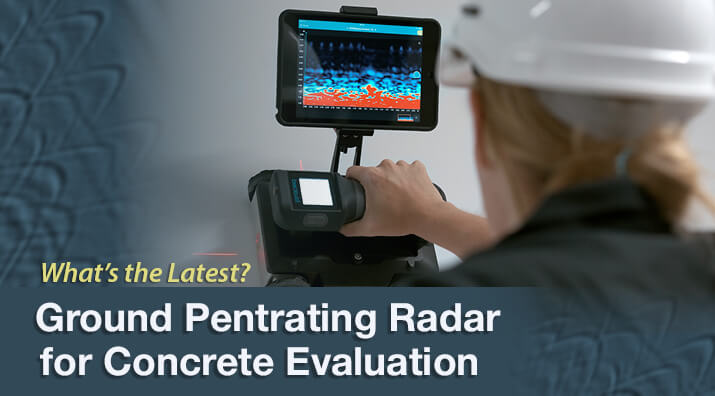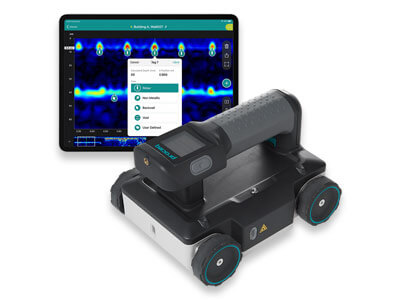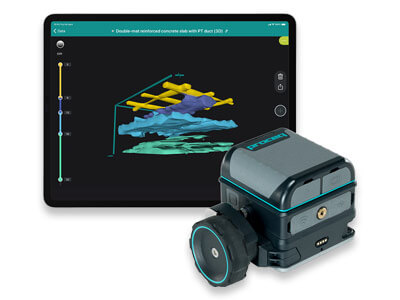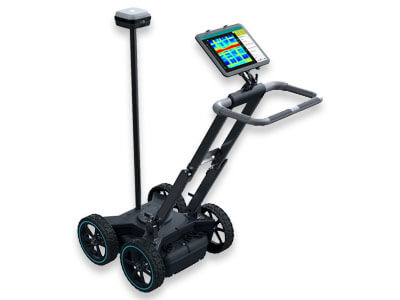
Table of Contents:
What is Ground Penetrating Radar
Ground penetrating radar (GPR) for the nondestructive evaluation of concrete is a relatively recent application for a mature technology. When a GPR transmitting antenna directs high-frequency radio waves into a solid surface, the waves scatter and reflect as they encounter objects or boundaries with different densities.
The reflected electromagnetic energy detected by the receiving antenna documents changes in the structure and density of the material. This non-intrusive method allows sub-surface investigations of structures, pavements, soil and rock, and detects variations in material properties like cracks and voids.
History of GPR
Patents for radar systems go as far back as 1904. In 1910, German researchers Gotthelf Leimbach and Heinrich Löwy filed a patent for using radar to locate buried objects. W. Stern performed the first known geophysical survey with GPR in 1929 by measuring the ice depth of a glacier in Austria.
GPR development stayed somewhat dormant until the 1970s when it was used for tunnel detection in the demilitarized zone between North and South Korea. Further interest in the civil engineering sector was driven by the need to map buried utilities and conduits under city streets accurately. Archeologists adapted models to investigate and map historical sites to minimize digging, and by 1980, affordable GPR systems were commercially produced.
Evaluating Concrete using GPR
Ground penetrating radar is a powerful tool when performing a nondestructive evaluation of hardened concrete. The most common applications include detection and mapping of reinforcing steel bars, tendons, and other embedments for measurement, confirmation of placement, and location before drilling or coring operations.
GPR scanning equipment also assesses homogeneity, measures thickness, and detects cracks, voids, and other discontinuities. Total GPR evaluation capabilities of concrete show the location and orientation of primary and secondary layers of reinforcing steel, cracks, defects and inclusions, location of conduits and ductwork, and overall dimensions. General quality and uniformity of concrete can be determined, and advanced corrosion of reinforcing steel bars can be detected if not accurately measured. Surveys of bridge decks reveal the thickness and homogeneity of asphalt layers on top of concrete.
GPR Concrete Scanning Equipment
Various manufacturers have produced sophisticated and reliable GPR devices capable of collecting valuable information about the condition of concrete and reinforcing elements. Until recently, some limitations of these available devices have hampered widespread adoption for concrete testing applications:
- Most transmitting and receiving antennas operate on a single fixed frequency of pulsed radar. In the simplest terms, a higher frequency yields the best signal resolution but the shallowest penetration depth. So, a high-frequency GPR instrument may be ideal for detecting shallow reinforcing steel but nearly useless for detecting deep embedments or discontinuities. More than one device is required for a truly complete appraisal of a structure.
- The GPR operator must have considerable training and experience to interpret the raw data displayed from the reflected signals accurately.
- Most GPR units put all the electronics for data collection, processing, and display in the same box with the signal generation, transmission, and receiving apparatus or rely on bulky cables connecting two boxes. Most upgrades or improvements to data processing power, performance, or display resolution require purchasing a new GPR device.
The engineering and product development team at Proceq/Screening Eagle went to work to remove these limitations and developed GPR systems with unique and innovative features:
- Proceq GPR Live units feature Stepped Frequency Continuous Wave (SFCW) circuitry. During scanning, these models transmit electromagnetic signals that sweep through a wide range of frequencies, automatically optimizing to achieve the greatest penetration depth and highest resolution characterization possible using a single antenna.
- Cutting edge data processing and migration and augmented reality (AR) programming allow clear and understandable 2D and 3D graphic displays of embedded items that can be overlaid on images of the scanned areas.
- Proceq GPR scanners connect wirelessly to an Apple iPad® for powerful data processing and a high-resolution display of graphics and values. Performance improvements to computing power and display resolution are made economically by updating to the latest iOS version or a newer iPad version. Built-in battery modules are hot-swappable, eliminating tangled cables and interruptions while scanning.
Modern ground penetrating radar units go beyond detection and location of reinforcing steel to offer a complete picture of in-place conditions. The encrypted Wi-Fi connection to the user's iPad® stores collected data securely in the cloud for instant sharing and collaboration with interested parties anywhere in the world. GPS-based positioning information ensures precise locations are recorded automatically.
- Popular compact units, such as the Proceq GP8000 models, collect and process scan data for open areas as large as 13x13ft (4x4m) or for linear scans up to 3,281ft (1,000m). These units are the best choice for typical applications like location and mapping of rebar and tensioning cables, measurement of cover depth, detection of voids and discontinuities, slab or wall thickness, and asphalt or concrete overlay thickness. These instruments accurately locate and size large reinforcing bars as much as 2ft (610mm) below the surface. Beyond that depth, they accurately detect voids, inclusions, delaminations, and embedded items.

- Handheld models like the Proceq GP8800 solve the problems of scanning in overhead areas, tight spaces with as little as 2.5in (63mm) of clearance, and curved surfaces. These units' cross-polarized scanning ability combines data from two perpendicular scans to significantly increase instrument sensitivity and resolution.

- Walk-behind utility scanning model Proceq GS8000 is mounted on carts and scans large areas with finished, paved, or off-road surfaces quickly for location and mapping of subsurface utility lines, geophysical investigations, and archeological studies. These units can collect data at ground speeds up to 22mph (35kph) and from depths to 12ft (3.7m) in average soils or a maximum of 33ft (10m).

The sweep of frequencies in the SFCW radar bandwidth varies by model but ranges from 0.2Ghz to 6Ghz overall. Maximum penetration and detection depths for handheld and compact devices are approximately 25 to 32in (64 to 81cm) and as much as 33ft (10m) for the walk-behind models.
We hope this blog post on the newest GPR technology for the nondestructive assessment of concrete has been helpful. Please contact our testing experts to discuss your application.

Published Standards
- ASTM D4748 Standard Test Method for Determining the Thickness of Bound Pavement Layers Using Short-Pulse Radar
- ASTM D6087 Standard Test Method for Evaluating Asphalt-Covered Concrete Bridge Decks Using Ground Penetrating Radar
- ASTM D6432 Standard Guide for Using the Surface Ground Penetrating Radar Method for Subsurface Investigation
- AASHTO R 37 Standard Practice for Application of Ground Penetrating Radar (GPR) to Highways















